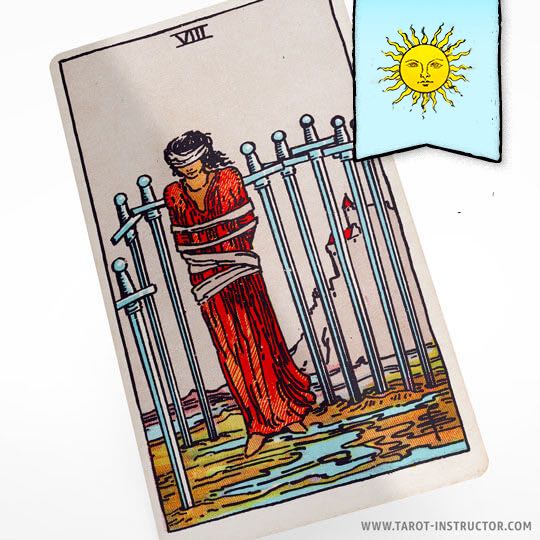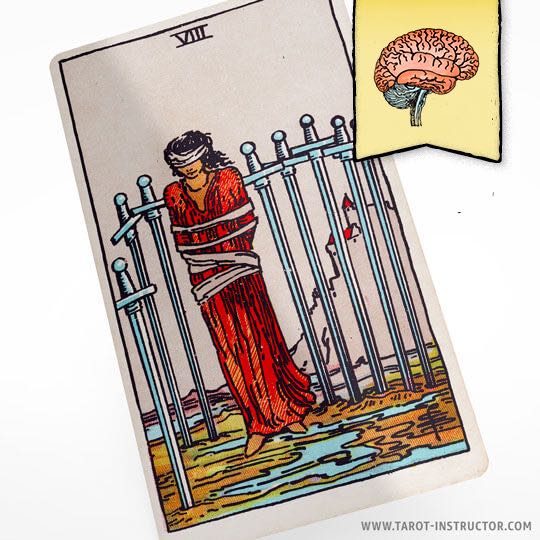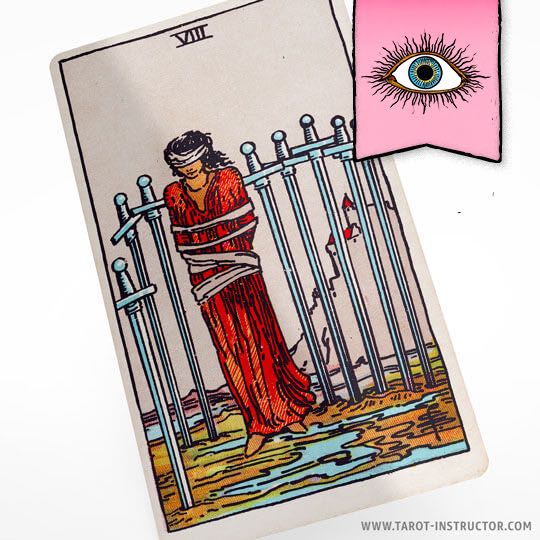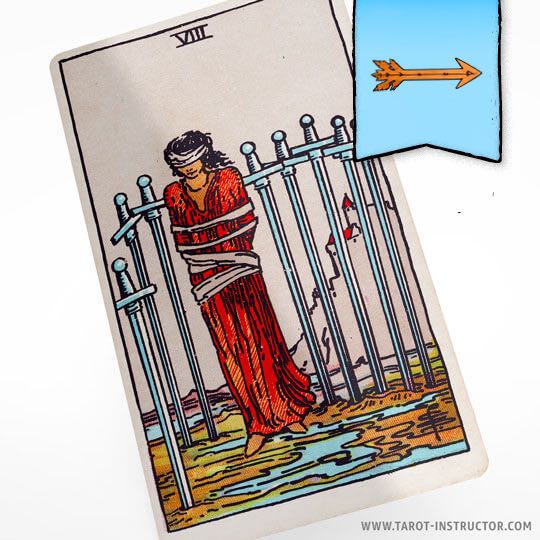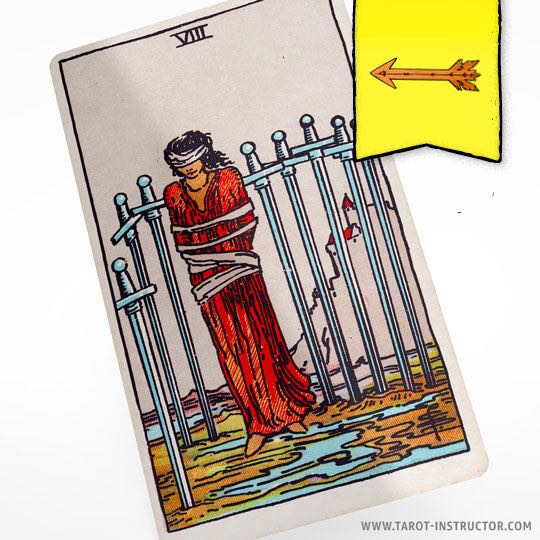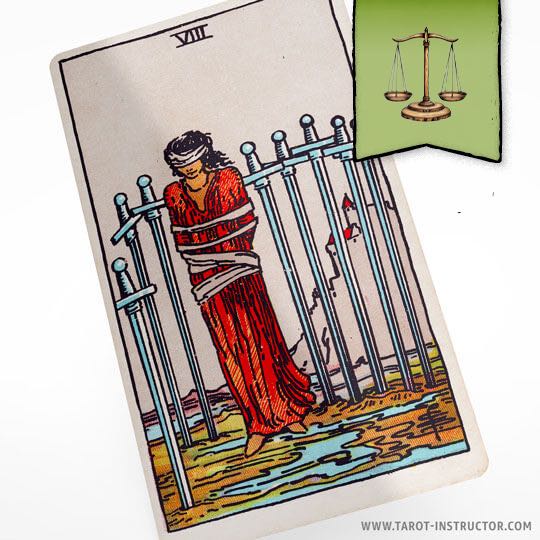Eight of Swords tarot card features following symbolic elements
Eight of Swords tarot card features following symbolic elements
Blindfold: Indicates denial about the relationship’s issues; feeling unaware may lead to future heartbreak if awareness isn’t gained. Bound Hands: Symbolizes a sense of helplessness; feelings of being trapped could lead to frustration, but acknowledging these feelings can foster communication. Eight Swords: Represents obstacles; confronting these challenges can transform feelings of entrapment into empowerment, leading to clarity and resolution. Water: Suggests emotional turmoil; unresolved feelings may cloud judgment, urging one to process emotions to avoid impulsive decisions in love. Landscape: Reflects isolation; feelings of disconnection may intensify, but recognizing this can encourage efforts to reconnect and revitalize the relationship.
Table of content
Eight of Swords as advice
„Free yourself from limiting beliefs.“
Eight of Swords keywords upright
Restriction, Feeling Trapped, Limitation, Fear, Awareness, Perspective.
Eight of Swords keywords reversed
Freedom, Release, Empowerment, Clarity, Liberation, Confidence.
Eight of Swords card element
Air
Eight of Swords zodiac sign
Gemini
Understanding the Eight of Swords as Past Upright and Reversed
The Eight of Swords is a powerful card in the Tarot deck, often representing restriction, confusion, and feelings of entrapment. When drawn in the context of past influences, the Eight of Swords as past can shed light on various aspects of relationships—whether they are potential, new, existing, or former. In this article, we will delve into the meanings of the Eight of Swords as past in the context of relationships, examining both upright and reversed positions to provide a comprehensive understanding of its implications in different relationship scenarios.
The Eight of Swords Card: An Overview
Understanding the Eight of Swords as past begins with recognizing the card’s symbolism. This card typically depicts a figure bound and blindfolded, surrounded by eight swords. It symbolizes feelings of being trapped, restricted, or unable to see a clear path forward. When interpreted in the context of the past, the Eight of Swords as past can indicate a time of confusion and self-imposed limitations. It suggests that past experiences may have created a mindset that hindered the individual from recognizing their power and agency in relationships.
The Eight of Swords as Past in Potential Relationships
Upright: When the Eight of Swords as past appears in the upright position concerning potential relationships, it signifies a time when the individual may have felt paralyzed by fear or uncertainty. This card indicates that, in the past, the person might have had opportunities for connection but was unable to pursue them due to self-doubt or negative thought patterns. They may have struggled to see the potential in new relationships, feeling overwhelmed by their insecurities.
In this state, the Eight of Swords as past highlights the need to recognize and confront these limiting beliefs. The individual may have wished for love and companionship but felt trapped by their own fears. As a result, potential relationships could have been overlooked or dismissed, leading to missed opportunities for deeper connections and experiences.
Reversed: When the Eight of Swords as past appears reversed in the context of potential relationships, it often indicates a turning point. The individual may have begun to break free from their past limitations and recognize their worth. They might have started to understand that the restrictions they previously felt were largely self-imposed.
In this reversed state, the Eight of Swords as past signifies a newfound clarity. The person may have taken steps to confront their fears, allowing them to open up to potential relationships. This shift in perspective could lead to a more optimistic outlook on love and companionship, paving the way for meaningful connections. Reflecting on this period, the individual may realize how overcoming their past constraints has empowered them to explore new romantic possibilities.
The Eight of Swords as Past in New Relationships
Upright: In the context of new relationships, the Eight of Swords as past in an upright position reflects a time filled with uncertainty and hesitation. The individual may have approached new romantic encounters with trepidation, feeling trapped by their past experiences or insecurities. This mindset could have led to a reluctance to fully engage and connect with new partners.
During this period, the Eight of Swords as past suggests that the individual might have found themselves caught in a cycle of overthinking. They may have analyzed potential partners excessively, fearing rejection or disappointment. This anxiety could have hindered their ability to enjoy new relationships, creating a barrier to genuine connection and intimacy.
Reversed: When the Eight of Swords as past appears reversed in the context of new relationships, it often signifies a significant shift. The individual may have begun to release the fears and anxieties that previously held them back. This newfound freedom allows them to embrace new relationships with an open heart and mind.
In this reversed state, the Eight of Swords as past suggests that the person is starting to recognize that their past does not have to dictate their future. They may have developed a greater sense of self-awareness, enabling them to engage more freely in new romantic encounters. Reflecting on this period, the individual may appreciate the growth they experienced as they moved beyond their previous limitations, allowing for deeper and more authentic connections.
The Eight of Swords as Past in Existing Relationships
Upright: When the Eight of Swords as past appears upright in the context of existing relationships, it can indicate a time of feeling trapped or confined within the partnership. The individual may have struggled with feelings of helplessness or confusion in the relationship, leading to a sense of emotional stagnation. This card suggests that the person may have felt unable to express their needs or desires, fearing that doing so would lead to conflict or rejection.
During this phase, the Eight of Swords as past signifies that miscommunication and misunderstandings may have flourished. The individual might look back and recognize how their fears prevented them from fully engaging with their partner, leading to a disconnect in the relationship. This realization can serve as a wake-up call, prompting them to address these issues to foster healthier communication moving forward.
Reversed: When the Eight of Swords as past appears reversed in the context of existing relationships, it often signals a period of growth and liberation. The individual may have begun to break free from the emotional constraints that previously hindered their relationship. This newfound clarity could lead to a willingness to communicate openly and honestly with their partner.
In this reversed state, the Eight of Swords as past highlights the importance of confronting issues head-on. The individual may have realized that by expressing their feelings and needs, they can foster a deeper connection with their partner. Reflecting on this change, the person might appreciate how overcoming past fears has strengthened their existing relationship, allowing for a more authentic and fulfilling bond.
The Eight of Swords as Past in Ex-Relationships
Upright: In the context of ex-relationships, the Eight of Swords as past upright can signify a time of feeling trapped or restricted within the partnership. The individual may look back on their previous relationship and recognize how their insecurities and fears contributed to its downfall. This card indicates that they might have felt powerless to change the dynamics of the relationship, leading to a sense of frustration and helplessness.
Reflecting on this ex-relationship, the individual may come to understand that the limitations they experienced were largely self-imposed. The Eight of Swords as past serves as a reminder that recognizing these patterns is crucial to healing and moving forward. The lessons learned from this experience can pave the way for healthier future relationships.
Reversed: When the Eight of Swords as past appears reversed in the context of ex-relationships, it often indicates a sense of liberation and growth. The individual may have finally let go of the emotional baggage associated with the past relationship. This card suggests that they have gained valuable insights from their experiences, allowing them to move forward with a clearer understanding of their needs and desires.
In this reversed state, the Eight of Swords as past signifies a newfound sense of empowerment. The individual may reflect on their ex-relationship and recognize how overcoming past limitations has enabled them to approach future relationships with greater confidence. This reflection can foster a sense of closure, allowing them to embrace new opportunities for love without being haunted by past fears.
Conclusion
The Eight of Swords as past is a card rich with meaning and implications, especially when considering its influence on relationships. In its upright position, it represents feelings of entrapment, confusion, and self-imposed limitations, while in its reversed state, it signifies liberation, growth, and the breaking of old patterns. By examining the Eight of Swords as past in various relationship scenarios—potential, new, existing, and ex-relationships—we can gain valuable insights into our past behaviors and choices.
Understanding these dynamics can empower individuals to embrace their journey toward love with renewed clarity and purpose. Whether learning from past mistakes or celebrating personal growth, the Eight of Swords as past reminds us that every relationship contributes to our understanding of ourselves and others. Ultimately, the journey through love is an opportunity for transformation, filled with lessons that shape who we are and who we aspire to be.
Source: Wikipedia Eight of Swords tarot card meaning
Reddit Eight of Swords
Quora Eight of Swords meaning
Unlock the mysteries of tarot cards.
